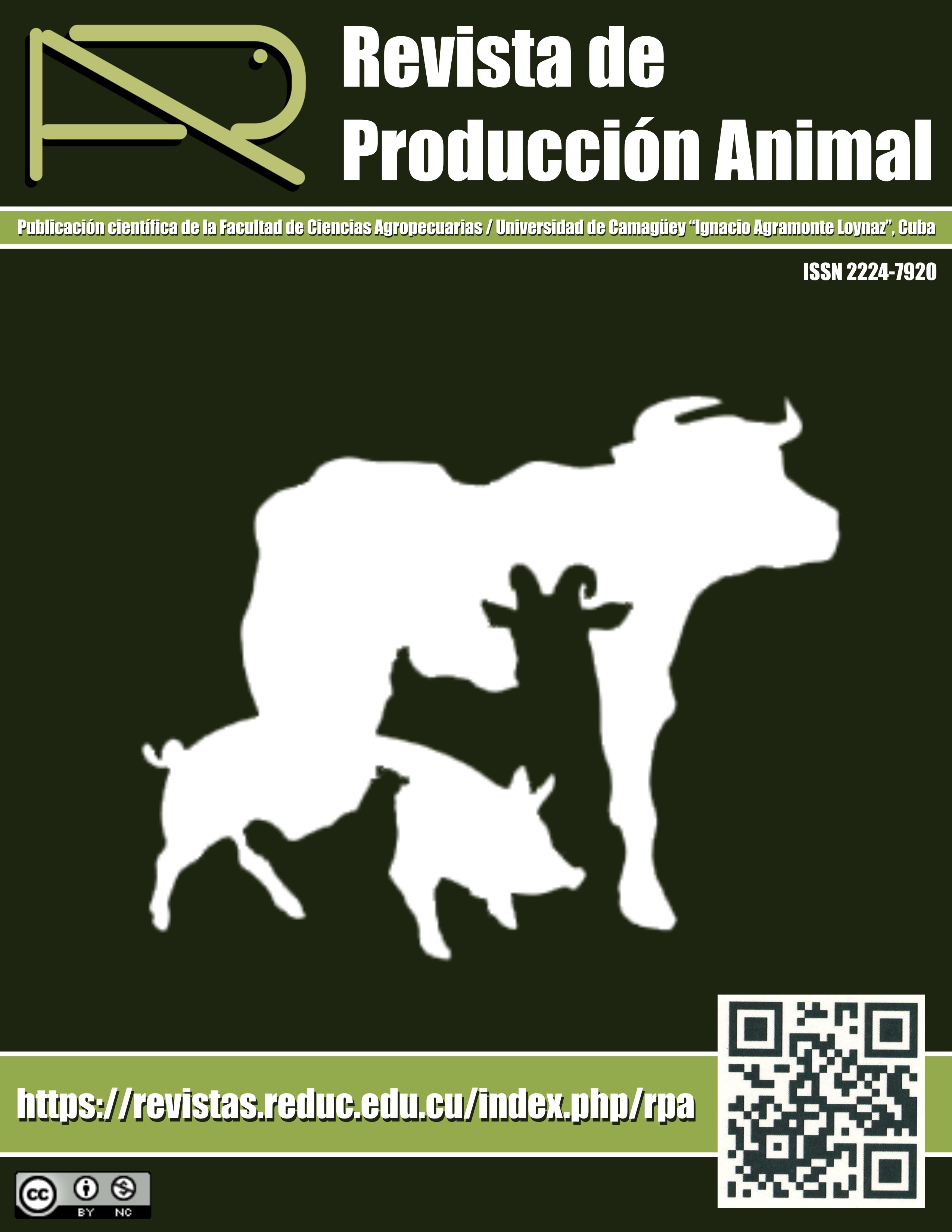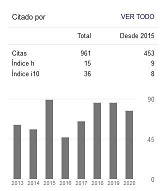Selección de cepas de Bacillus productoras de enzimas con potencialidades para la alimentación animal
Resumen
Antecedentes: El incremento de la conciencia sobre los problemas medioambientales ha conducido a la implementación de alternativas ecológicas en la producción industrial. Las celulasas y las hemicelulasas son las enzimas más empleadas a nivel industrial; su uso garantiza la eficacia de los procesos productivos con la disminución en el empleo de sustancias químicas que contaminan el medio ambiente. Seleccionar cepas de Bacillus spp. productoras de celulasas, β-mananasas y xilanasas para su utilización en la alimentación animal. Materiales y métodos: Se estudiaron diez cepas las cuales se inocularon en placas con medio mínimo suplementado con xilano de haya, goma de algarrobo y carboximetilcelulosa para la producción de xilanasas, β-mananasas y endocelulasas respectivamente. Las placas se incubaron a 37 ºC durante 24 horas y se cubrieron con una disolución de rojo congo al 0,5%. Se determinó el diámetro de la zona de hidrólisis y el de la colonia para calcular el índice de potencia. Resultados: De las cepas evaluadas todas mostraron la capacidad de producir las enzimas en estudio. El 23,3% de las actividades enzimáticas estudiadas se consideró como buena. Bacillus subtilis E-44 resultó como la cepa que manifestó la mejor actividad enzimática en los tres sustratos evaluados con índices de potencia de 3,01 ± 1,18; 3,82 ± 0,31 y 4,22 ± 0,23 para celulasas, β-mananasas y xilanasas respectivamente. Conclusiones: Bacillus subtilis E-44 se seleccionó como la mejor cepa en la producción de celulasas y hemicelulasas, lo que incrementa las potencialidades de su uso en la alimentación animal y en la industria de los alimentos.
Palabras clave: β-mananasas, bacteria, endocelulasas, hemicelulasas, xilanasas (Fuente: MeSH)
Descargas
Citas
Behera, B. C., Sethi, B. K., Mishra, R. R., Dutta, S. K., and Thatoi, H. N. (2017). Microbial cellulases – Diversity and biotechnology with reference to mangrove environment : A review. Journal of Genetic Engineering and Biotechnology, 15(1), 197–210. https://doi.org/10.1016/j.jgeb.2016.12.001
Benatti, A. L. T., and Polizeli, M. de L. T. de M. (2023). Lignocellulolytic Biocatalysts: The Main Players Involved in Multiple Biotechnological Processes for Biomass Valorization. Microorganisms, 11(162). https://doi.org/https://doi.org/10.3390/microorganisms11010162
Blibech, M., Mouelhi, S., Farhat-Khemakhem, A., Boukhris, I., Ayeb, A. El, and Chouayekh, H. (2019). Selection of Bacillus subtilis US191 as a mannanase-producing probiotic candidate. Biotechnology and Applied Biochemistry, 66(5), 858–869. https://doi.org/10.1002/bab.1798
Cann, I., Pereira, G. V., Abdel-Hamid, A. M., Kim, H., Wefers, D., Kayang, B. B., Kanai, T., Sato, T., Bernardi, R. C., Atomi, H., and Mackie, R. I. (2020). Thermophilic Degradation of Hemicellulose , a Critical Feedstock in the Production of Bioenergy and Other Value-Added Products. Applied and Environmental Microbiology, 86(7), e02296--19. https://doi.org/10.1128/AEM.02296-19
Chauhan, P. S., and Gupta, N. (2016). Insight into microbial mannosidases : a review. Critical Reviews in Biotechnology, 8, 1–12. https://doi.org/10.3109/07388551.2015.1128878
Danilova, I., and Sharipova, M. (2020). The Practical Potential of Bacilli and Their Enzymes for Industrial Production. Frontiers in Microbiology, 11(1782). https://doi.org/10.3389/fmicb.2020.01782
Gonzalez-Gonzalez, M. del R., and Miranda- Lopez, R. (2022). Cellulases, hemicellulases and ligninolytic enzymes: mechanism of action, optimal processing conditions and obtaining value-added compounds in plant matrices. MOJ Food Processing and Technology, 10(1), 30–37. https://doi.org/10.15406/mojfpt.2022.10.00270
Gusakov, A. V, Kondratyeva, E. G., and Sinitsyn, A. P. (2011). Comparison of Two Methods for Assaying Reducing Sugars in the Determination of Carbohydrase Activities. International Journal of Analytical Chemistry, 2011(283658), 1–4. https://doi.org/10.1155/2011/283658
Kaur, A., Soni, S. K., Vij, S., and Rishi, P. (2021). Cocktail of carbohydrases from Aspergillus niger: an economical and eco-friendly option for biofilm clearance from biopolymer surfaces. AMB Express, 11(1), 22. https://doi.org/10.1186/s13568-021-01183-y
Latorre, J. D., Hernandez-Velasco, X., Kuttappan, V. A., Wolfenden, R. E., Vicente, J. L., Wolfenden, A. D., Bielke, L. R., Prado-Rebolledo, O. F., Morales, E., Hargis, B. M., and Tellez, G. (2015). Selection of Bacillus spp. for cellulase and xylanase production as direct-fed microbials to reduce digesta viscosity and Clostridium perfringens proliferation using an in vitro digestive model in different poultry diets. Frontiers in Veterinary Science, 2(25). https://doi.org/10.3389/fvets.2015.00025
Latorre, J. D., Hernandez-Velasco, X., Wolfenden, R. E., Vicente, J. L., Wolfenden, A. D., Menconi, A., Bielke, L. R., Hargis, B. M., and Tellez, G. (2016). Evaluation and Selection of Bacillus Species Based on Enzyme Production, Antimicrobial Activity, and Biofilm Synthesis as Direct-Fed Microbial Candidates for Poultry. Frontiers in Veterinary Science, 3(95). https://doi.org/10.3389/fvets.2016.00095
Li, F., Xie, Y., Gao, X., Shan, M., Sun, C., Niu, Y. D., and Shan, A. (2020). Screening of cellulose degradation bacteria from Min pigs and optimization of its cellulase production. Electronic Journal of Biotechnology, 48, 29–35. https://doi.org/10.1016/j.ejbt.2020.09.001
Liu, G., Zhang, K., Gong, H., Yang, K., Wang, X., Zhou, G., Cui, W., Chen, Y., and Yang, Y. (2023). Whole genome sequencing and the lignocellulose degradation potential of Bacillus subtilis RLI2019 isolated from the intestine of termites. Biotechnology for Biofuels and Bioproducts, 16(130), 1–19. https://doi.org/10.1186/s13068-023-02375-3
Luise, D., Bosi, P., Raff, L., Amatucci, L., Virdis, S., and Trevisi, P. (2022). Bacillus spp . Probiotic Strains as a Potential Tool for Limiting the Use of Antibiotics, and Improving the Growth and Health of Pigs and Chickens. Frontiers in Microbiology, 13(801827), 1–19. https://doi.org/10.3389/fmicb.2022.801827
Ma, L., Lu, Y., Yan, H., Wang, X., Yi, Y., Shan, Y., Liu, B., Zhou, Y., and Lü, X. (2020). Screening of cellulolytic bacteria from rotten wood of Qinling (China) for biomass degradation and cloning of cellulases from Bacillus methylotrophicus. BMC Biotechnology, 20(1), 1–13. https://doi.org/10.1186/s12896-019-0593-8
Marimuthu, M., Sorimuthu, A., and Muruganantham, S. (2019). Production and Optimization of Xylanase Enzyme from Bacillus subtilis using Agricultural Wastes by Solid State Fermentation. International Journal of Pharmaceutical Investigation, 9(4), 169–173. https://doi.org/10.5530/ijpi.2019.4.32
Milián, G., Rondón, A. J., Pérez, M., Boucourt, R., Rodríguez, M., Portilla, Y., Pérez, Y., Beruvides, A., and Laurencio, M. (2017). Characterization of Bacillus subtilis strains as candidates for the preparation of animal additives. Cuban Journal of Agricultural Science, 51(2), 1–8. https://www.cjascience.com/index.php/CJAS/article/view/728/752
Milián, G., Rondón, A. J., Pérez, M., Samaniego, L. M., Riaño, J., Bocourt, R., Ranilla, M. J., Carro, M. D., Rodríguez, M., and Laurencio, M. (2014). Isolation and identification of strains of Bacillus spp. in different ecosystems, with probiotic purposes, and their use in animals. Cuban Journal of Agricultural Science, 48(4), 347–351. https://www.cjascience.com/index.php/CJAS/article/view/562/526
Moreno, M. L. O., and Vélez, D. U. (2011). Nuevo método para la cuantificación de la actividad endoglucanasa basado en el complejo celulosa-rojo congo. Orinoquia, 15(1), 7–15. https://www.redalyc.org/articulo.oa?id=89621344002
Mousa, G. A., Allak, M. A., Shehata, M. G., Hashem, N. M., and Hassan, O. G. A. (2022). Dietary Supplementation with a Combination of Fibrolytic Enzymes and Probiotics Improves Digestibility , Growth Performance, Blood Metabolites, and Economics of Fattening Lambs. Animals, 12(476), 1–13. https://doi.org/10.3390/ani12040476
Riaz, T., Khan, F. S.-U., and Shakoori, F. R. (2019). Screening and optimization of cultural conditions for production of thermophilic mannanase from Bacillus megaterium. Punjab University Journal of Zoology, 34(2), 175–183. https://doi.org/10.17582/journal.pujz/2019.34.2.175.183
Rodrigues, I. da S. V., Barreto, J. T., Moutinho, B. L., Oliveira, M. M. G., da Silva, R. S., Fernandes, M. F., and Fernandes, R. P. M. (2020). Production of xylanases by Bacillus sp. TC-DT13 in solid state fermentation using bran wheat. Preparative Biochemistry and Biotechnology, 50(1), 91–97. https://doi.org/10.1080/10826068.2019.1663536
Sathitkowitchai, W., Sathapondecha, P., Angthong, P., Srimarut, Y., Malila, Y., Nakkongkam, W., Chaiyapechara, S., Karoonuthaisiri, N., Keawsompong, S., and Rungrassamee, W. (2022). Isolation and Characterization of Mannanase-Producing Bacteria for Potential Synbiotic Application in Shrimp Farming. Animals, 12(2583), 1–17. https://doi.org/10.3390/ani12192583
Su, Y., Liu, C., Fang, H., and Zhang, D. (2020). Bacillus subtilis: A universal cell factory for industry, agriculture, biomaterials and medicine. Microbial Cell Factories, 19(1), 1–12. https://doi.org/10.1186/s12934-020-01436-8
Sulistiyani, T. R., Kusmiati, M., and Putri, G. A. (2021). The 16S rRNA Analysis and Enzyme Screening of Bacillus from Rhizosphere Soil of Lombok Island. Jurnal Ilmu Pertanian Indonesia, 26(4), 582–590. https://doi.org/10.18343/jipi.26.4.582
Teather, R. M., and Wood, P. J. (1982). Use of Congo Red-Polysaccharide Interactions in Enumeration and Characterization of Cellulolytic Bacteria from the Bovine Rument. Applied and Environmental Microbiology, 43(4), 777–780. https://doi.org/10.1128/aem.43.4.777-780.982
Weschenfelder, L. M., Elisa, C., Oro, D., Cansian, R. L., Teixeira, A. J., Dalponte Menegat, F., Menoncin Weschenfelder, L., Demaman Oro, C. E., Astolfi, V., Valduga, E., Zeni, J., Toniazzo Backes, G., Cansian, R. L., Weschenfelder, L. M., Elisa, C., Oro, D., and Cansian, R. L. (2023). Enzymatic hydrolysis of lignocellulosic residues and bromatological characterization for animal feed. Ciência Rural, 53(7), 1–11. https://doi.org/terization for animal feed. http://doi.org/10.1590/0103-8478cr2021072
Zhang, Z., Raza, M. F., Zheng, Z., Zhang, X., Dong, X., y Zhang, H. (2018). Complete genome sequence of Bacillus velezensis ZY-1-1 reveals the genetic basis for its hemicellulosic/cellulosic substrate-inducible xylanase and cellulase activities. 3 Biotech, 8(465), 1–7. https://doi.org/10.1007/s13205-018-1490-x
Derechos de autor 2023 Revista de Producción Animal

Esta obra está bajo licencia internacional Creative Commons Reconocimiento-NoComercial 4.0.
Los autores de los artículos publicados en RPA retienen los derechos de autor de su trabajo, de marca y patente, y también sobre cualquier proceso o procedimiento descrito en el artículo, así como a compartir, copiar, distribuir, ejecutar y comunicar públicamente el artículo publicado en la RPA o cualquier parte de aquel siempre que indiquen la fuente de publicación (autores del trabajo, revista, volumen, número y fecha), pero están de acuerdo en que la revista publique los trabajos bajo una licencia Creative Commons.
![]() Licencia Attribution-NonCommercial 4.0 International (CC BY-NC 4.0)
Licencia Attribution-NonCommercial 4.0 International (CC BY-NC 4.0)






































